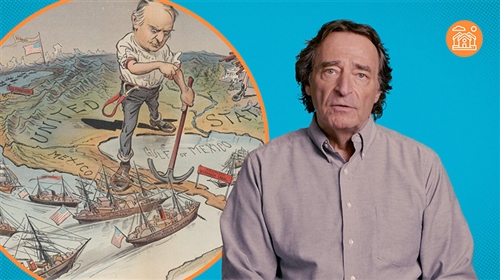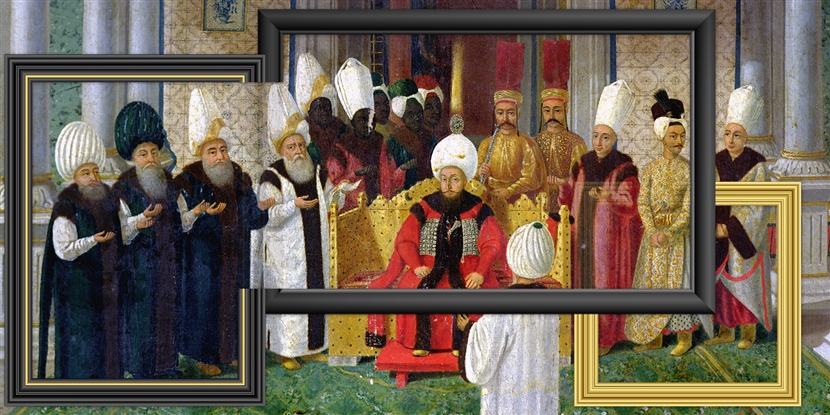By Trevor R. Getz
San Francisco, USA
There’s a classroom problem we all face. There’s just too much history to teach, especially in a world history course covering hundreds, thousands, or even millions of years. On one level, that means we have to pick and choose. Which histories are the most important? Whose stories get told? There are all kinds of judgements to be made here about what is “world historical.” What were the most important events, and which trends are vital for our students to understand our world today?
But beneath this problem lurks an even bigger issue. World history is so fast that, without organizing narratives, students can’t help but see it as just a bunch of unrelated pieces. As a result, students can’t really redesign their concept of the human past. They just take pieces of new information and find ways to plug them into the story of world history they already have in their head.
 Bob Bain discussing Unit 5
Bob Bain discussing Unit 5
What is a frame?
Teachers and historians have known for a long time that we have to find a way to help students organize the pieces of world history, and for us that’s meant coming up with frames.
A frame is a filter we put on the past to make sense of the information we are receiving. Our predecessors have come up with all kinds of schemes for organizing these filters. One of the most popular is SPRITE (social, political, religion, intellectual, technological, and economic). Another is BEST PAL (belief systems, economics, society, technology, politics, arts, location). These filters are important to understand because the same event, when viewed through a different frame, can tell us different things. For example, the Cold War was a political conflict, but also a clash of ideas, belief systems, and economies. These frames may overlap, but they are each distinct.
Frames are more than just ways of understanding a single event or trend, however. They also connect history, revealing long-term patterns. Frames help students generate big questions. And that’s a really important point. A frame is not in itself an answer. A frame is a question. For example: “How do people make and distribute the things they need?” or “How do societies organize themselves?” or “How do people from different communities relate to and share with each other?”
Why these frames, and not others?
I picked those particular questions because they relate specifically to the three frames in the World History Project—communities, networks, and production and distribution—represented by these three icons.

Yup, that’s right, we only use three frames. That’s because students just don’t have enough time in a world history class to deal with more.
But why these three frames? We think that they convey the ideas and invite the questions that are particularly important to a world history course. Through the communities frame, students can compare and contrast the way that different societies have organized themselves, acknowledging the diversity of strategies and identities that make up the rich world in which we live. Through the production and distribution frame, they can explore issues of work, wealth, poverty, and innovation—past and present. The networks frame mobilizes the key elements of world history—the connections and networks that make the human experience more than just a local or national endeavor.
Using the frames
Students encounter the three frames early in WHP. And you and your students revisit the frames again and again. Teachers tell us that students are hesitant to apply the frames at first, but then become more and more confident as they progress, applying them as tools for building their own, evidence-based narratives about the past.
In both the Origins and 1750 versions of the WHP course, students begin by watching four short videos—one on the overall concept of frames, and then one on each of the three frames. Each video not only explains the frames but tells a history of the world—in about one minute—through each frame. We call these frame narratives. With these ideas firmly in mind, WHP students embark on their voyage of discovery.
Each subsequent unit includes a special video that describes the unit’s subject matter through one or more of the frames. These videos, like this one on the Industrial Revolution, model the application of frames for students.
But that isn’t where the real magic happens. The big leap takes place when students do the work themselves. This happens mainly through the Three Close Reads lesson plans attached to each article, video, or activity. These plans culminate in questions asking students to use the material to evaluate the narratives of the frames we have given them. Students often use these materials to support our frame narratives, but in many cases, they can also use them to extend (or modify) those narratives, or to challenge them. In the process, students modify the story of the past that they have in their head.
Ultimately, frames are tools for making history comprehensible and helping students to create or modify their big stories about the past. How will you use them in your classroom?
About the author: Trevor Getz is professor of African and world history at San Francisco State University. He has written or edited 11 books, including the award-winning graphic history Abina and the Important Men, and coproduced several prize-winning documentaries. He is also the author of A Primer for Teaching African History, which explores questions about how we should teach the history of Africa in high school and university classes.
Cover image: Composite image. Reception at the Court of the Sultan Selim III (1761-1807), Topkapi Palace Museum, Istanbul, Turkey (oil on canvas). ©Getty Images / Hulton Fine Art Collection.
 For full access to all OER Project resources AND our amazing teacher community,
For full access to all OER Project resources AND our amazing teacher community, 
